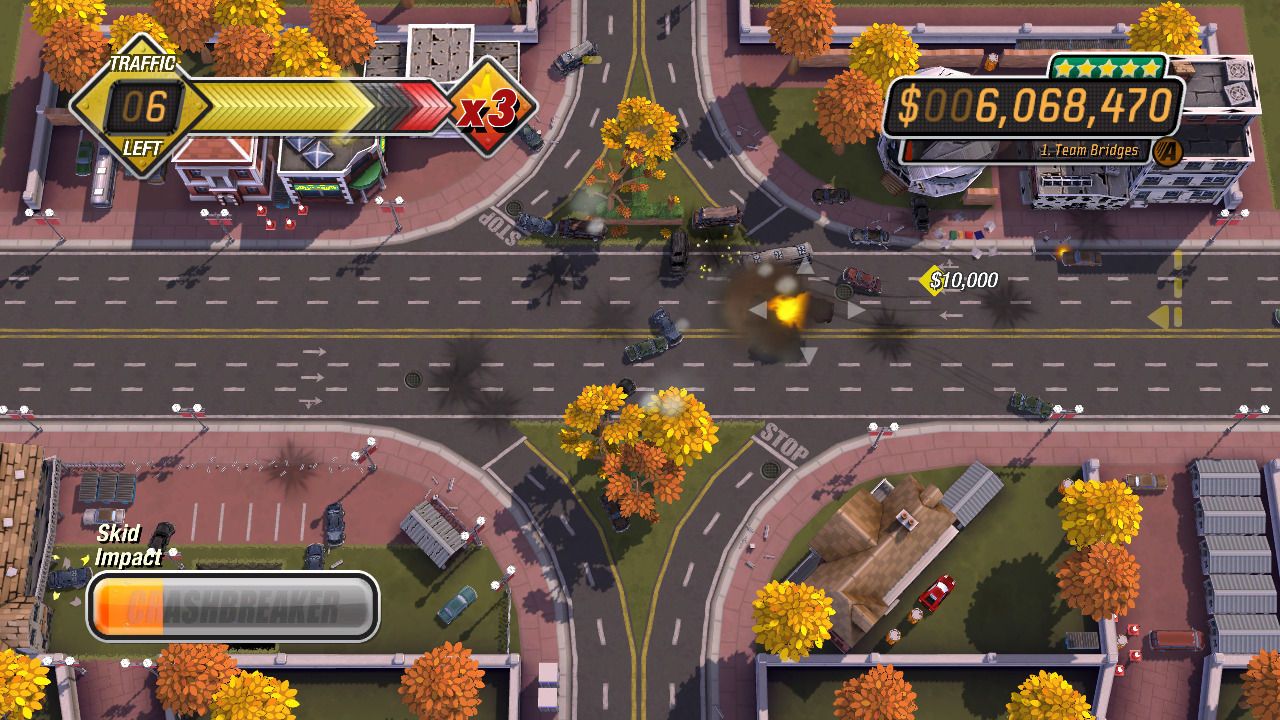Burnout Crash Review
Posted by
sirdesmond
on
One of the most memorable aspects of the Burnout series over the years has been the Crash mode first making its appearance in Criterion Games’ Burnout 2 all the way back in 2002. After this first inclusion, it became a staple of the franchise, continuing to make regular appearances throughout the series before evolving into Showtime mode in 2009’s Burnout Paradise. Burnout Crash, Criterion Games’ new downloadable entry in the Burnout franchise, is at the same time a simplification and evolution of this tried and true formula. Entirely re-skinned and set aside from the other gameplay elements, Burnout Crash comes off as a mixed bag of solid ideas coupled with lackluster design and presentation.

At a basic level, Burnout Crash plays like the standard Crash mode found in previous Burnout titles blended with pinball (minus the flippers). You pick from one of eighteen different intersections to play on, carefully drive your car into the intersection inciting a wreck, then utilize the game’s explosive Aftertouch feature to blow up your surroundings and send your car flying in such a way as to keep the wrecks piling up and the buildings blowing up. In the game’s primary mode titled Road Trip, you are tasked with continuing the wreck as long as possible until you either let five vehicles escape unscathed or wreck enough cars to trigger all of the intersections’ different events – such as making massive sinkholes appear, spawning a level-clearing tornado, or even causing a huge plane crash that ends the level and gives you a massive point boost. All throughout this mode, players are given a number of smaller challenges that can act to lower your missed vehicle counter, block off portions of the intersection, etc.

Two additional game modes come off as being somewhat confusing and a bit half-baked. Not so aptly named Rush Hour and Pile Up, the first has you simply attempting to cause as much damage as you can within 90 seconds without a penalty for missed vehicles; while the second provides a limited number of vehicles, and challenges you to keep fires burning across buildings and vehicles as long as possible. Rush Hour is a bit easier to understand and to play than even the default Road Trip mode. It feels a bit odd that it wasn’t made the primary play mode. Pile Up is just a bit strange and not very satisfying. It’s clear they had to stretch things a bit in order to get a higher number of game modes which I’m not sure was entirely necessary in the end.
While this may be tied specifically to my experience and others may not have this problem, I found the game’s many challenges (earning you stars used to unlock new levels and different vehicles) to be fairly difficult. Typically, I found myself earning anywhere from 0 to 2 stars per intersection and game mode without having to replay the level heavily. This necessary replaying could be by design which is a bit upsetting, but it is fitting with the game’s arcade mentality overall. Either way, try not to be frustrated if you find yourself having to go back and play previous intersections over and over in order to gain enough stars to progress further.

A game like this screams for multiplayer modes featuring two-player simultaneous crashes and pass-the-controller hot seat play. Unfortunately, Criterion decided to keep multiplayer entirely out of the picture for those without Kinect and to give those that do own a Kinect a frustrating and just unnecessary way to play the game. Known as Kinect Party, Burnout Crash’s multiplayer has you and your opponent taking turns playing across the game’s different intersections and instead of using the traditional controller, you lean back and forth around your environment to shift your car’s direction and perform some kind of humiliating action in order to set off your Aftertouch explosion. Simply put, it is a dreadful way to play the game and a massive misstep in terms of the game’s multiplayer potential. It also cuts a lot of value and content out of the game for those without a Kinect.

Burnout Crash is an amalgamation of the basic concepts of Criterion’s original Crash mode, removed from the impressive visuals and realistic art direction that previously added so much, coupled with a pinball sensibility that comes off just a bit too cheesy to really be all that enjoyable. The entire game feels a bit half-baked and like something that could have been much more enjoyable without the gimmicky 80s pinball machine aesthetics and complete abandonment of anything even slightly reminiscent of the previous Burnout titles. Fans of arcade-style games may find a lot of fun to be had with Burnout Crash, but other, more serious gamers and fans of the previous Burnout titles beware. This may not be the Crash Mode you were looking for.
